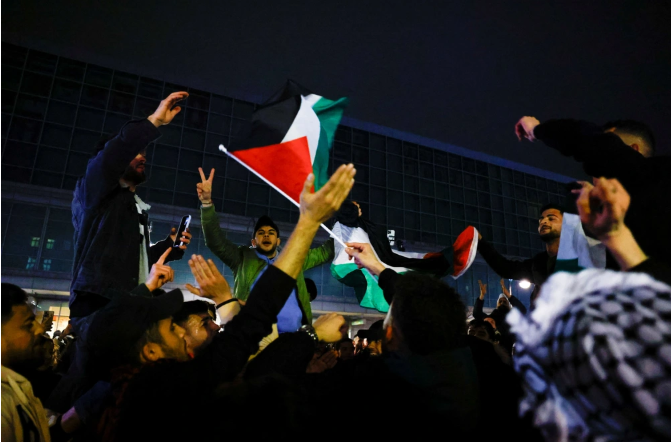
The situation in the Middle East has taken a significant turn as negotiations in Qatar for a new ceasefire between Israel and Hamas have been successful.

On January 15, on his social media, US President-elect Donald Trump officially announced that “Israel and Hamas have reached an important agreement, ensuring the release of all Israeli hostages held by Hamas”.
According to international media channels, the ceasefire agreement in the Gaza Strip that has just been reached includes 3 phases that will take effect on January 19. Phase 1 of the agreement lasts for 42 days, during which the Israeli army will withdraw to the East of Gaza; Hamas will release 33 hostages including women, children, the elderly, the injured or sick. In return, Israel will release a number of Palestinian prisoners; displaced Gazans will be able to return home and humanitarian aid will be increased to Gaza.
Previously, on January 13, after phone calls with the Israeli Prime Minister and the Emir of Qatar, US President Joe Biden optimistically declared that “A ceasefire agreement in Gaza is within reach”. In addition, when answering the Newsmax television channel, President-elect Donald Trump also commented: “The ceasefire agreement in Gaza is very close and could be reached by the end of this week”.
Reactions of the parties
Immediately after the ceasefire agreement was announced, the Hamas movement issued a statement affirming that “the ceasefire agreement is the result of the extraordinary perseverance of the Palestinian people and the courageous resistance of this force in Gaza for more than 15 months”. Hamas also expressed gratitude to the countries that have shown solidarity with the people of Gaza, standing side by side with the Palestinian people, especially the mediators who have made every effort to reach the agreement.
On the Israeli side, President Isaac Herzog said on television that “the ceasefire agreement between Israel and Hamas is the right step to bring all those who were captured back home”.
Among the Arab countries involved, Egyptian President Abdel Fattah el-Sisi “welcomed the ceasefire that has been achieved after more than a year of tireless efforts by Egyptian, Qatari and American mediators”, and stressed the importance of quickly delivering humanitarian aid to the people of Gaza.
On the US side, President Joe Biden expressed pride that the US would participate in monitoring the agreement, saying that “the elements of this agreement are what he detailed in May 2024”. President-elect Donald Trump strongly praised the newly reached agreement, calling it “the beginning of great things to come for America and the world”.
Speaking to reporters at the UN headquarters, UN Secretary-General Antonio Guterres praised the Egyptian, Qatari and American mediators “for their efforts in brokering this ceasefire agreement”. Türkiye, Saudi Arabia, South Africa, the European Union (EU) and many member countries in the bloc… also welcomed the ceasefire agreement.
Why did the negotiations succeed so quickly?
President-elect Donald Trump was quick to declare that “this ceasefire agreement was only possible because of our historic victory in November, because it signals to the world that my administration will seek peace and negotiate agreements that keep all Americans and our allies safe.”
However, the ceasefire and prisoner/hostage talks in Doha this time went smoothly and quickly reached an agreement thanks to many different factors, first of all the two opposing sides, Israel and Hamas, followed by the mediators, with the US as the leading and most important country.
First of all, both the opposing sides, Israel and Hamas, saw this as the time for a ceasefire. Israel hoped that through the ceasefire, Hamas would release some of the approximately 100 hostages still being held in Gaza. Meanwhile, the Hamas movement is eager to end the Israeli military campaign, ensure the import of reconstruction materials to Gaza, and release Palestinian prisoners held in Israel.
On the Hamas side, the daring raid on Israel on October 7, 2023, although a very spectacular and meaningful victory, led to the entire Gaza Strip being reduced to rubble by the Israeli army. In the context of Hamas being seriously wounded, a ceasefire with the Israeli withdrawal from Gaza paving the way for the process of strengthening Hamas and rebuilding Gaza is extremely important and urgent, especially when its ally Hezbollah agreed to a ceasefire with Israel in November 2024, making Hamas more isolated than ever.
On the Israeli side, comprehensive retaliation against the Hamas movement and significantly weakening both Iran and Hezbollah has led to a new situation in the Middle East that is favorable to the Jewish state. However, Israel has only fulfilled half of its commitment to “punish Hamas properly”, and has not yet “brought all hostages home” as Prime Minister Netanyahu has repeatedly declared. This is what makes the Israeli people still not satisfied and continues to put great pressure on the government.
In addition, no matter how great Israel’s military victory is, in the long run, Israel will hardly become more peaceful and secure, because “violence begets violence”, it is only a matter of time.
On the US side, unlike previous times, this ceasefire agreement is being promoted by both the current and elected US Presidents. Both sent special envoys to Qatar and Israel to promote the ceasefire agreement.
In addition, President Joe Biden also brought Secretary of State Antony Blinken to the region to directly meet and work with the parties. As President Biden enters his final days in the White House, after all that has happened in the past four years, he certainly wants a ceasefire agreement to leave a positive mark on the Middle East issue.
As for the newly re-elected President, with his decisive and timely personality, Mr. Trump also does not want to sit back and watch Mr. Biden reap success on this issue alone. At the same time, Mr. Trump also wants to show special attention to the very important Jewish ally and contribute to reducing a thorny international issue to be resolved after taking office. In fact, Mr. Trump has warned that “everything will be costly” if the hostages are not released before he takes office.
Significance of the ceasefire agreement
After more than a year of fighting, in November 2023, Israel and Hamas reached a single ceasefire, under which Hamas released more than 100 women, children and foreigners in exchange for 240 Palestinians detained by Israel. The agreement reached this time is much more important, as it brings a long-term and comprehensive ceasefire in the always hotly contested region.
Specifically, the Doha agreement on a phased ceasefire has concluded more than a year of continuous negotiations. This agreement will first of all help end the war that has devastated the Gaza Strip, which has severely weakened the Hamas armed resistance movement and forced the majority of Palestinians in this land to become “homeless” when they have to move to many places. The ceasefire will also open up the prospect of resuming the Israeli-Palestinian negotiations on a two-state solution to break the deadlock in finding a reasonable, just and sustainable solution to the crisis that has lasted for decades.
The ceasefire between Israel and Hamas could also ease tensions across the Middle East, where the Israel-Hamas war has triggered a chain reaction that has led to fierce armed conflicts in the West Bank, Lebanon and to some extent in Syria, Yemen and Iraq, while raising concerns about a full-scale war with unpredictable consequences.
With this momentum, the recently reached ceasefire agreement could also help open up a new situation in the Middle East. Accordingly, the trend of negotiating mutual concessions will prevail over the use of force to resolve conflicts.
For the US, this agreement will help President Biden achieve a significant achievement
on the foreign front in his luggage when leaving office, while increasing the prestige and voice of the US in the region. The agreement also contributes to creating a position for President-elect Trump and his “peace through strength” policy, while helping the new administration have more time and resources to focus more comprehensively on the remaining goals in the ambitious MAGA agenda.
What should the parties do?
On the evening of January 15, the Israeli army continued airstrikes on the Gaza Strip. Therefore, the urgent task at hand is for the mediators and the international community to continue to help and call on both Israel and Hamas to immediately end the fighting before the ceasefire takes effect on January 19.
Next is to strongly deploy humanitarian activities for the people in the Gaza Strip, first of all in terms of food, medicine, and medical equipment to ensure the most essential necessities for the people here.
According to Egyptian security sources on January 15, coordination is underway to open the Rafah border crossing between Egypt and Gaza to bring international aid to the Palestinian people in the strip. Egypt will also provide the largest possible amount of humanitarian aid to the people of Gaza.
Finally, the reconstruction of Gaza in all aspects from the ruins, which requires hundreds of billions of dollars that the Palestinians cannot afford on their own. This requires the help of the international community, countries and international financial institutions.
With a long history of complex conflicts and deep distrust between Israel and Palestine over the past half century, although all parties have shown their determination to reach a ceasefire agreement, deep differences and each side’s own strategic calculations may still be obstacles to the smooth implementation of the recently reached ceasefire agreement.
This requires strong support from the international community for a sustainable and just peace in the region, first of all from major countries, Arab countries as well as the steadfastness and efforts of both Israel and Hamas in particular, the Palestinians in general and countries in the region to fully and seriously implement the terms of the agreement.




